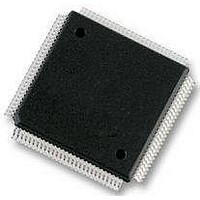MC912D60CCPVE Freescale Semiconductor, MC912D60CCPVE Datasheet - Page 150

MC912D60CCPVE
Manufacturer Part Number
MC912D60CCPVE
Description
IC MCU 16BIT 112-LQFP
Manufacturer
Freescale Semiconductor
Series
HC12r
Datasheet
1.MC912D60ACFUE8.pdf
(460 pages)
Specifications of MC912D60CCPVE
Core Processor
CPU12
Core Size
16-Bit
Speed
8MHz
Connectivity
CAN, MI Bus, SCI, SPI
Peripherals
POR, PWM, WDT
Number Of I /o
68
Program Memory Size
60KB (60K x 8)
Program Memory Type
FLASH
Eeprom Size
1K x 8
Ram Size
2K x 8
Voltage - Supply (vcc/vdd)
4.5 V ~ 5.5 V
Data Converters
A/D 16x8/10b
Oscillator Type
Internal
Operating Temperature
-40°C ~ 85°C
Package / Case
112-LQFP
Processor Series
HC912D
Core
HC12
Data Bus Width
16 bit
Data Ram Size
2 KB
Interface Type
CAN, SCI, SPI
Maximum Clock Frequency
8 MHz
Number Of Programmable I/os
86
Maximum Operating Temperature
+ 85 C
Mounting Style
SMD/SMT
3rd Party Development Tools
EWHCS12
Minimum Operating Temperature
- 40 C
On-chip Adc
10 bit, 8 Channel
Lead Free Status / RoHS Status
Lead free / RoHS Compliant
Available stocks
Company
Part Number
Manufacturer
Quantity
Price
Company:
Part Number:
MC912D60CCPVE
Manufacturer:
FREESCAL
Quantity:
203
Company:
Part Number:
MC912D60CCPVE
Manufacturer:
Freescale Semiconductor
Quantity:
10 000
- Current page: 150 of 460
- Download datasheet (5Mb)
Clock Functions
11.6.5 Executing the STOP instruction without Limp Home mode, clock monitor enabled
11.6.6 STOP exit in Limp Home mode with Delay
Technical Data
150
CAUTION:
(NOLHM=1, CME=1, DLY=X)
If the NOLHM bit and the CME (or FCME) bits are set, a clock monitor
failure is detected when a STOP instruction is executed and the MCU
resets via the clock monitor reset vector.
(NOLHM=0, CME=X, DLY=1)
If the NOLHM bit is cleared, then the CME (or FCME) bit is masked when
a STOP instruction is executed to prevent a clock monitor failure. When
coming out of STOP mode, the MCU goes into limp-home mode where
CME and FCME signals are asserted.
When using a crystal oscillator, a normal STOP exit sequence requires
the DLY bit to be set to allow for the crystal stabilization period.
With the 13-stage counter clocked by the VCO (at f
delay of 4096 XCLK cycles at the limp-home frequency, if the clock
monitor indicates the presence of an external clock, the limp-home mode
is de-asserted and the MCU exits STOP normally using EXTALi clock.
Where the crystal start-up time is longer than the initial count of 4096
XCLK cycles, or in the absence of an external clock, the MCU recovers
from STOP following the 4096 count in limp-home mode with both the
LHOME flag set and the LHIF limp-home interrupt request set to indicate
it is not operating at the desired frequency. Each time the 13-stage
counter reaches a count of 4096 XCLK cycles, a check of the clock
monitor status is performed.
When the presence of an external clock is detected, limp-home mode is
exited and the LHOME flag is cleared. This sets the limp-home interrupt
flag and if enabled by the LHIE bit, the limp-home mode interrupt is
requested.
The clock monitor circuit can be misled by EXTALi clock into reporting a
good signal before it has fully stabilised. Under these conditions,
Clock Functions
MC68HC912D60A — Rev. 3.1
Freescale Semiconductor
VCOMIN
), following a
Related parts for MC912D60CCPVE
Image
Part Number
Description
Manufacturer
Datasheet
Request
R
Part Number:
Description:
Manufacturer:
Freescale Semiconductor, Inc
Datasheet:
Part Number:
Description:
Manufacturer:
Freescale Semiconductor, Inc
Datasheet:
Part Number:
Description:
Manufacturer:
Freescale Semiconductor, Inc
Datasheet:
Part Number:
Description:
Manufacturer:
Freescale Semiconductor, Inc
Datasheet:
Part Number:
Description:
Manufacturer:
Freescale Semiconductor, Inc
Datasheet:
Part Number:
Description:
Manufacturer:
Freescale Semiconductor, Inc
Datasheet:
Part Number:
Description:
Manufacturer:
Freescale Semiconductor, Inc
Datasheet:
Part Number:
Description:
Manufacturer:
Freescale Semiconductor, Inc
Datasheet:
Part Number:
Description:
Manufacturer:
Freescale Semiconductor, Inc
Datasheet:
Part Number:
Description:
Manufacturer:
Freescale Semiconductor, Inc
Datasheet:
Part Number:
Description:
Manufacturer:
Freescale Semiconductor, Inc
Datasheet:
Part Number:
Description:
Manufacturer:
Freescale Semiconductor, Inc
Datasheet:
Part Number:
Description:
Manufacturer:
Freescale Semiconductor, Inc
Datasheet:
Part Number:
Description:
Manufacturer:
Freescale Semiconductor, Inc
Datasheet:
Part Number:
Description:
Manufacturer:
Freescale Semiconductor, Inc
Datasheet:











